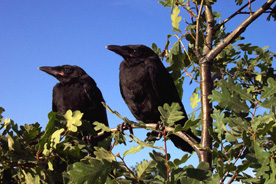| |

|
Social system and helping at the nest
At many sites in Europe , carrion crows breed in socially monogamous pairs and their offspring disperse early, about 4-5 weeks after fledging. In northern Spain , however, crows form stable groups of 3 to 9 individuals and breed cooperatively in about 75% of territories.
In this population, sociality arises both through delayed dispersal of offspring who stay on the natal territory associated with one or both parents for up to four years, and through immigration into the territories of individuals that are related to the dominant breeder of the same sex.
Social groups are therefore extended families where both retained offspring and immigrants can act as helpers, assisting the breeding pair in feeding the new chiks, cleaning the nest and defending the territories from predators and conspecific intruders. |
 |
|
Analyses of paternity based on microsatellites revealed that, besides the dominant breeding male, also adult male immigrants often sire some young, while non-dispersing offspring do not, and so avoid incest. Social groups live year-round in all-purpose territories, but in winter they usually roost communally with other crows and sometimes use communal feeding grounds when food in the territories is scarce.
|
|
|





